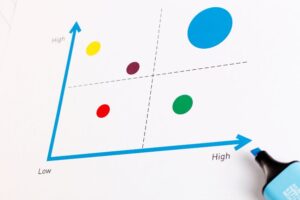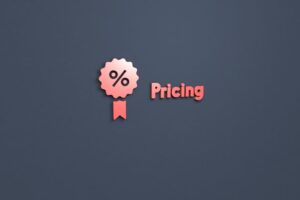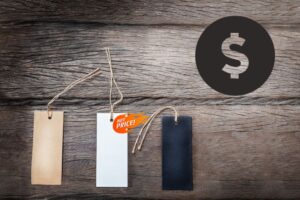What is Captive Product Pricing?
Captive product pricing is when a company bundles together two separate products and only sells them as a package. Often, one product is what consumers really want — let’s call that the “core” product.
The other product is something that complements the core product. It’s known as the captive product. Companies use captive product pricing to get you to buy that extra, complementary product by bundling it with the desirable anchor product.
A common example of this strategy can be seen in the cell phone industry and service contracts. When you purchase a cell phone, you are often offered the option to sign a service contract with a specific provider. This contract typically includes a monthly fee that covers both the cost of the phone and the cellular service.
By bundling the cost of the phone with the service contract, cell phone companies can offer the latest smartphones at a discounted price. However, the real cost is in the monthly service fees, which are usually higher than if you purchased the phone outright and chose a different service provider.
MORE: What is decoy pricing?
Pros and Cons of Captive Product Pricing
Here are some significant benefits and drawbacks of using captive product pricing:
| Pros | Cons |
|---|---|
| Companies can charge more for the captive products since customers don’t have a choice | A lack of choice can lead to customer dissatisfaction and frustration |
| Once customers buy into the bundle, they’re likely to keep purchasing the captive products from the same company | This strategy may lead to customer resentment over time |
| Companies can provide a seamless and integrated customer experience when offering captive products | Captive product pricing strategies, when taken to an extreme, can resemble monopolistic practices |
| Captive product pricing can provide more predictable and stable revenue streams for businesses | Stable revenue from captive product pricing can sometimes make companies complacent, leading to a lack of innovation |
| When customers consistently receive high-quality captive products, it can build trust and loyalty towards the brand | Customers may grow tired of limited choices and seek more diverse options |
MORE: What is enterprise pricing?
Captive Product Pricing Examples
Captive product pricing is popular among many companies. Here are a few real-world captive product pricing example:
1. Software-as-a-Service (SaaS)
Software companies like Dropbox, Adobe Suite, and Google Drive offer their tools through paid subscription plans. Free versions are usually available with limited features, but for the full suite of tools, users have to subscribe to one of their pricing tiers.
MORE: What is usage pricing?
2. Gaming Consoles and Video Games
Major gaming console manufacturers such as Sony (PlayStation) and Microsoft (Xbox) use captive pricing to their advantage. These companies often sell their gaming consoles at a relatively low price, knowing that gamers will need to purchase proprietary video games and accessories like a controller.
3. Printer Manufacturers and Ink Cartridges
Printer manufacturers like HP, Epson, and Canon utilize captive pricing by offering printers at affordable prices. However, they compensate for the low-profit margins by selling ink cartridges at a higher price. Consumers who purchase these printers have no choice but to continue buying the specific ink cartridges.
4. Gaming Apps and In-App Purchases
The mobile gaming industry is another captive product pricing example. These apps entice players with addictive gameplay and then offer in-app purchases to enhance the gaming experience, such as power-ups, extra lifelines, or exclusive features. Players who are invested in the game often feel compelled to make purchases.
5. 3D Printers and Printer Filaments
Similar to traditional printers, 3D printer manufacturers like Stratasys and Proto Labs implement captive pricing by offering their printers at competitive prices. They then make up for it by selling 3D printer filaments at higher margins. Since consumers must use specific filaments compatible with their 3D printers, manufacturers profit from the ongoing need for supplies.
MORE: What is charm pricing?

How to Implement Captive Product Pricing
Here are practical steps to implement captive product pricing:
1. Identify a Product Bundle
Look for two products where one has high demand and the other has little demand on its own. Both products have to complement each other, for example, razor handles with disposable razor cartridges.
The product with high demand (razor handles) will be the “driver” that captivates customers. The product with little demand (razor cartridge) is the “captive” product.
MORE: What is high low pricing
2. Price the Bundle Attractively
Price the bundle so it seems like an appealing deal to customers. The captive product should seem heavily discounted so the bundle is hard to pass up. In the razor example, offer the handle at a steep discount price and throw in the captive cartridges at a premium.
3. Require the Purchase of the Captive Product
Specify that customers must buy the captive product to get the driver product. Don’t sell the driver product for sale on its own. This forces customers to pay for the captive product if they want the driver product.
4. Market the Driver Product
Focus your marketing efforts on promoting the desirable driver product. Highlight its benefits and value. The captive product is secondary—you want customers captivated by the driver product.
5. Consider a Subscription Model
A subscription model, where customers pay regular fees for the captive product, is ideal for captive product pricing. This approach provides ongoing revenue and a reason for customers to stick with your product bundle. Using the razor example again, customers subscribe to receive new cartridges on a recurring basis.
MORE: What is odd even pricing?
Is Captive Pricing Right for Your Business?
To decide if captive pricing is a good fit for your company, you must evaluate the following factors:
1. Market power
Does your company have sufficient market power in its industry to sustain higher prices through captive channels? Higher prices may drive away some customers and reduce demand, so market dominance can help mitigate this risk.
2. Customer Loyalty
How loyal are your existing customers? Captive pricing works best for companies with a highly loyal customer base that is less sensitive to price increases. Customer loyalty programs can help reinforce this.
3. Product Differentiation
How differentiated are your products or services? Higher prices may be more justifiable for unique offerings that have few substitutes. However, undifferentiated products will likely face more resistance to price hikes. (Make sure you have professional product photos)
4. Cost Structure
Do you have high fixed costs and lower variable costs? This cost structure can make higher prices through captive channels more profitable. However, captive pricing limits the ability to benefit from economies of scale.
5. Competition
What competitive threats do you face? Competitors offering alternative channels or products may erode the benefits of captive pricing over time. You’ll need strategies to counteract this.
MORE: How do trial pricing strategies work?
6. Regulation
Are there any relevant regulations that could restrict your ability to utilize captive pricing? Some industries face more regulatory scrutiny of captive pricing strategies.
MORE: What is penetration pricing?
Key Takeaways
Captive product pricing is an intelligent strategy to increase sales of a product that lacks demand on its own. By bundling it with a must-have item and requiring customers to buy both together, you can charge more for the captive product than you otherwise could.
However, it is crucial to implement this model carefully and ethically. While higher prices can drive profits, you must maintain a balance that does not alienate customers or invite new competitors.
Finding the right match between business goals, customer needs, and the value provided is key to ensuring the effectiveness of captive product pricing.
Check out SaaSGenius to uncover more business tips, software solutions, and hacks that will not only enable you to implement your pricing strategy right, but also boost your business performance.
Related Posts
Frequently Asked Questions (FAQ)
Author
Methodology
- Who?
We are SaaS experts: Our specialists constantly seek the most relevant information to help support your SaaS business. - Why?
We are passionate about users accessing fair SaaS pricing: We offer up-to-date pricing data, reviews, new tools, blogs and research to help you make informed SaaS pricing decisions. - How?
With accurate information: Our website manager tests each software to add a Genius Score using our rating methodology to each product. Our editorial team fact-check every piece of content we publish, and we use first-hand testing, value metrics and leading market data.










